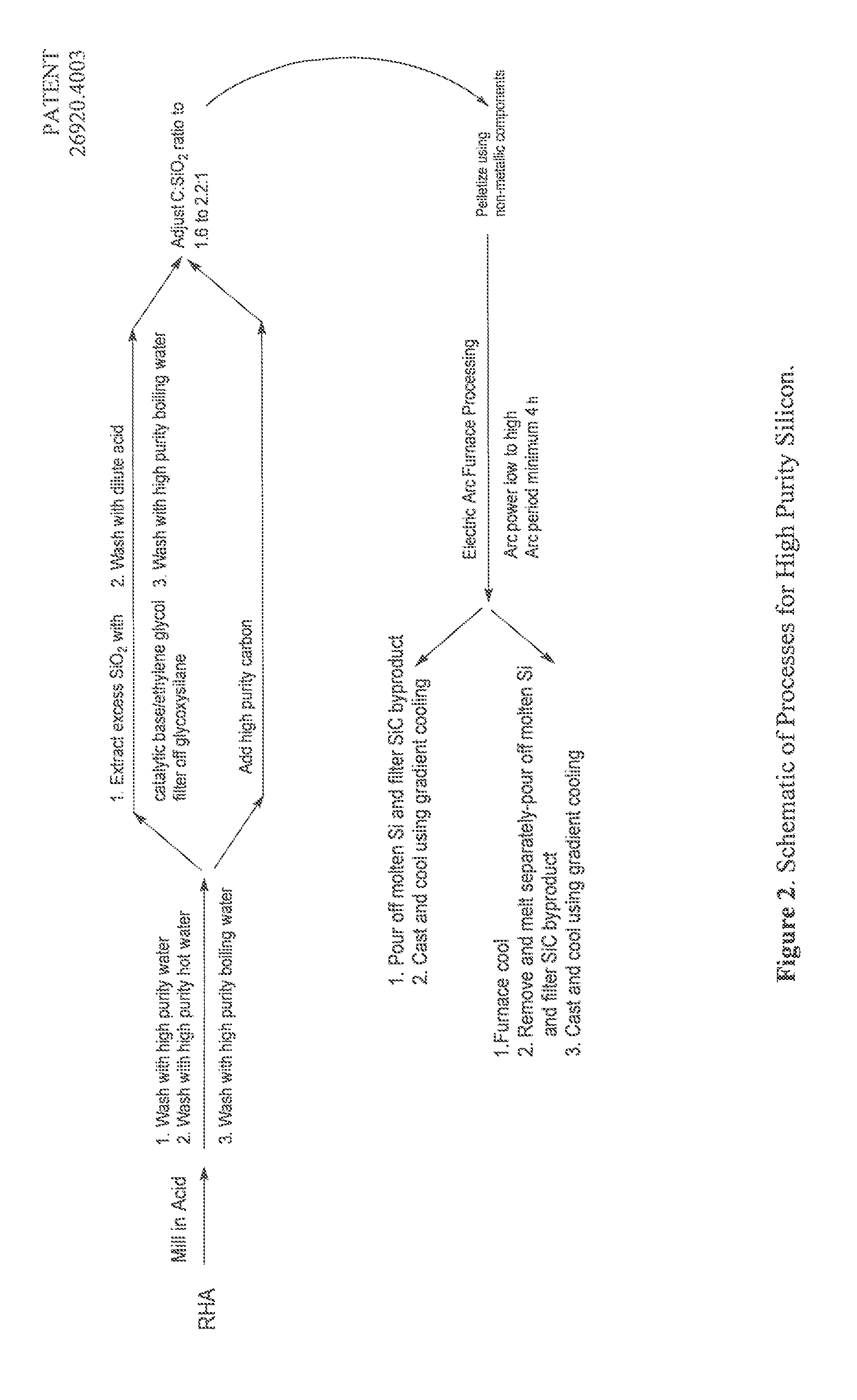Biogenic silica as a raw material to create high purity silicon
a technology of biogenic silica and high-purity silicon, which is applied in the direction of silicon compounds, glass tempering apparatuses, manufacturing tools, etc., can solve the problems of high cost of silicon-based pv solar cells, the extremely high purity silicon used in pv cells, and the inherent cost of manufacturing processes that isolate and purify the silicon contained, so as to reduce the cost of materials, reduce the cost of energy, and reduce processing time
- Summary
- Abstract
- Description
- Claims
- Application Information
AI Technical Summary
Benefits of technology
Problems solved by technology
Method used
Image
Examples
example 1
Conversion of Purified RHA to Si Via EAF Carbothermal Reduction, Single Batch Process
[0049]4.3 kg of purified RHA (similar to Table 4 after complete process) was mixed with 615 g of high purity graphite powder, then 2.3 L of distilled water was added and the slurry was formed into 40-50 g spherical pellets. Pellets were dried for 8 h at 225° C. then placed inside the EAF. Power was quickly increased from the initial 2 kW to 16 kW at 200 kw / min; it took 6 h for all the RHA to react. 220 g of silicon was collected, analysis shown in Table 5 column 2. EAF used in these experiments is the 50 kW single top electrode direct current EAF using graphite walls described above.
example 2
Conversion of Purified SDRHA to Si Via EAF Carbothermal Reduction, Single Batch Process
[0050]Silica depleted RHA (SDRHA) was prepared by reacting milled RHA (milled in 3.7 wt. % HCl, then washed in water, then neutralized using 10 wt. % ammonium hydroxide solution) in ethylene glycol (36.2 L) and catalytic amount of sodium glycolate silicate (3.94 mole of SGS) where 40 wt. % of the silica was extracted. SDRHA was then filtered, washed in water, then acid leached in 6.7 wt % HCL, then washed in boiling water. Pellets were dried for 8 h at 250° C. 265 g of high purity graphite powder was added and 3.2 L of distilled water was added and the slurry was formed into 40-50 g spherical pellets. Pellets were dried for 8 h at 250° C. then placed inside the EAF. Power was quickly increased from the initial 2 kW to 16 kW at 200 kw / min; it took 6 h for all the RHA to react. 110 g of silicon was collected. The analysis is given in Table 8 below.
TABLE 8Analysis of Si produced from SDRHA. (all numb...
example 3
Conversion of Purified RHA to Si Via EAF Carbothermal Reduction, Multi Batch Batch Process
[0051]9.5 kg of purified RHA (similar to Table 4 after complete process) was mixed with 1273 g of high purity graphite powder, then 7 L of distilled water was added and the slurry was formed into 40-50 g spherical pellets. Pellets were dried for 8 h at 225° C. ⅓ of the pellets were placed in the EAF. Power was quickly increased from the initial 5 kW to 11 kW in 30 minutes, after 4 hours power was reduced to 7 kW; another ⅓ of the pellets was added after 8 h, then the final third after 13 h. Total run time was 19 h. 350 g of silicon was collected, analysis shown in Table 6, column 2.
PUM
| Property | Measurement | Unit |
|---|---|---|
| diameter | aaaaa | aaaaa |
| temperatures | aaaaa | aaaaa |
| temperature | aaaaa | aaaaa |
Abstract
Description
Claims
Application Information
 Login to View More
Login to View More - R&D
- Intellectual Property
- Life Sciences
- Materials
- Tech Scout
- Unparalleled Data Quality
- Higher Quality Content
- 60% Fewer Hallucinations
Browse by: Latest US Patents, China's latest patents, Technical Efficacy Thesaurus, Application Domain, Technology Topic, Popular Technical Reports.
© 2025 PatSnap. All rights reserved.Legal|Privacy policy|Modern Slavery Act Transparency Statement|Sitemap|About US| Contact US: help@patsnap.com



